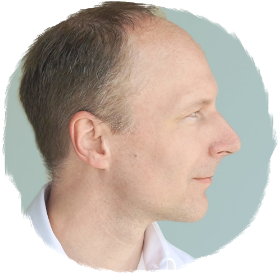In the previous video we were lying on the belly, and rolled the pelvis a little bit to the left and to the right. Here’s a screenshot from one of my prep sessions:

How your pelvis connects to your head (UP9.1), youtube.com/watch?v=XOxG5hDnstk
A fairly simple move, yet my video for this movement is half an hour long. And I would think it could be much longer than that. It could be an entire workshop. This movement looks simple, but it’s quite complex. Just for example: during pregnancy women should feel their baby move at month 5 at the latest. The baby is starting to use its legs to push against the inner lining of the womb (which she might feel as kicking), and in this way the baby starts to learn how to use its legs to change position. In movement classes we can mimic this developmental stage by, for example, by lying on the back and pushing with one foot (or both feet) on the floor (or on a wall, or ball or anything really) to roll or lift the pelvis and change position. However, when we are lying on the belly, we can’t make use of our feet and legs in this sense. It’s a more challenging situation that reflects a later stage in our developmental and movement learning process.
Now, for my next video. First of all, I was browsing through my personal notes and got inspired by one of Moshé Feldenkrais original lessons, AY385, Increasing the spreading of the knees (which could be tagged #scout series, and snapshots of some movements thereof would resemble the Yoga Pigeon pose). Here’s a screenshot from one of my prep sessions:

It’s basically the same movement as in the previous video, rolling the pelvis a little bit to the left and to the right in prone position, however, with one leg bent (which we need in the „From The Ground Up” series).
And yet, it’s such an utterly different situation that it completely changes the lesson and how I need (to learn and) to teach it. Well, maybe not for everyone. But if you are like me, and your legs and body in general is not in mint condition anymore, which is to say does not provide normal service anymore (to paraphrase Moshé Feldenkrais), which is to say that you can’t do every humanly possible movement with ease and a complete sense of taken-for-grantedness anymore (like a duck takes to water), then it’s an utterly different situation.
Well, who is.
So, for my next video, I spent the last two weeks trying to learn this movement, and moreover, trying to figure out a way how to teach it. For most of the time it didn’t look like I will succeed. I had issues with my knees, and I had difficulties getting to the bottom of the lesson, and I had somewhat of an existential crisis (which is probably less because of this movement lesson, and more due to two years of ongoing lockdowns and living in a foreign country with little to no chance to ever learning the local language or becoming fully integrated in society, and yet no way I’m going back to the mess my home country Austria has become).
But at last, finally, after two weeks of approximations and pursue, it looks like as if I’m successful in this process of creating a new lesson. I finally have a clear understanding of the movements and how they fit in the overall pattern of the series. And I found a way to prime and protect the knees, which I think is a rather big insight. It might change how I will teach most classes in the future, and how I understand movement learning in general. And I’ve already taught the movements to two very different students, which yielded important insights on how to teach this particular lesson on Youtube. I think I will soon be able to film the video.





